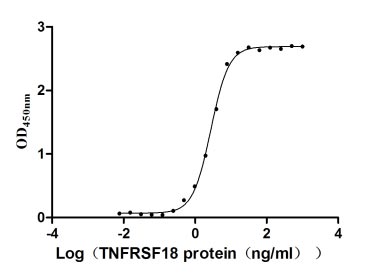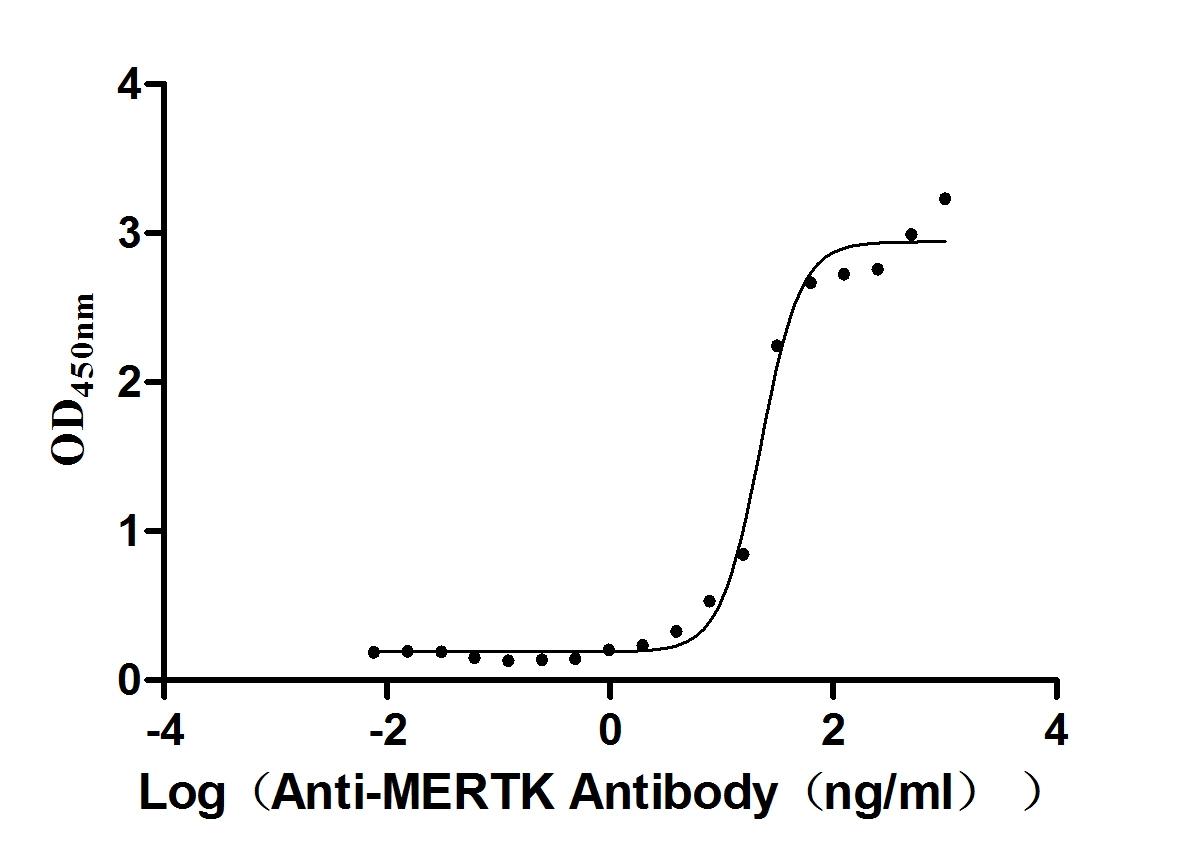Recombinant Human Metalloreductase STEAP4 (STEAP4), partial
-
货号:CSB-YP731557HU1
-
规格:
-
来源:Yeast
-
其他:
-
货号:CSB-EP731557HU1
-
规格:
-
来源:E.coli
-
其他:
-
货号:CSB-EP731557HU1-B
-
规格:
-
来源:E.coli
-
共轭:Avi-tag Biotinylated
E. coli biotin ligase (BirA) is highly specific in covalently attaching biotin to the 15 amino acid AviTag peptide. This recombinant protein was biotinylated in vivo by AviTag-BirA technology, which method is BriA catalyzes amide linkage between the biotin and the specific lysine of the AviTag.
-
其他:
-
货号:CSB-BP731557HU1
-
规格:
-
来源:Baculovirus
-
其他:
-
货号:CSB-MP731557HU1
-
规格:
-
来源:Mammalian cell
-
其他:
产品详情
-
纯度:>85% (SDS-PAGE)
-
基因名:STEAP4
-
Uniprot No.:
-
别名:STEAP4; STAMP2; TNFAIP9; Metalloreductase STEAP4; Six-transmembrane epithelial antigen of prostate 4; SixTransMembrane protein of prostate 2; Tumor necrosis factor, alpha-induced protein 9
-
种属:Homo sapiens (Human)
-
蛋白长度:Partial
-
蛋白标签:Tag type will be determined during the manufacturing process.
The tag type will be determined during production process. If you have specified tag type, please tell us and we will develop the specified tag preferentially. -
产品提供形式:Lyophilized powder
Note: We will preferentially ship the format that we have in stock, however, if you have any special requirement for the format, please remark your requirement when placing the order, we will prepare according to your demand. -
复溶:We recommend that this vial be briefly centrifuged prior to opening to bring the contents to the bottom. Please reconstitute protein in deionized sterile water to a concentration of 0.1-1.0 mg/mL.We recommend to add 5-50% of glycerol (final concentration) and aliquot for long-term storage at -20℃/-80℃. Our default final concentration of glycerol is 50%. Customers could use it as reference.
-
储存条件:Store at -20°C/-80°C upon receipt, aliquoting is necessary for mutiple use. Avoid repeated freeze-thaw cycles.
-
保质期:The shelf life is related to many factors, storage state, buffer ingredients, storage temperature and the stability of the protein itself.
Generally, the shelf life of liquid form is 6 months at -20°C/-80°C. The shelf life of lyophilized form is 12 months at -20°C/-80°C. -
货期:Delivery time may differ from different purchasing way or location, please kindly consult your local distributors for specific delivery time.Note: All of our proteins are default shipped with normal blue ice packs, if you request to ship with dry ice, please communicate with us in advance and extra fees will be charged.
-
注意事项:Repeated freezing and thawing is not recommended. Store working aliquots at 4°C for up to one week.
-
Datasheet :Please contact us to get it.
相关产品
靶点详情
-
功能:Integral membrane protein that functions as NADPH-dependent ferric-chelate reductase, using NADPH from one side of the membrane to reduce a Fe(3+) chelate that is bound on the other side of the membrane. Mediates sequential transmembrane electron transfer from NADPH to FAD and onto heme, and finally to the Fe(3+) chelate. Can also reduce Cu(2+) to Cu(1+). Plays a role in systemic metabolic homeostasis, integrating inflammatory and metabolic responses. Associated with obesity and insulin-resistance. Involved in inflammatory arthritis, through the regulation of inflammatory cytokines. Inhibits anchorage-independent cell proliferation.
-
基因功能参考文献:
- These findings suggest that increased STEAP4 mRNA expression is associated with inflammatory stimuli, whereas lower STEAP4 expression is associated with obesity in human islets. PMID: 28405880
- STEAP4 plays role in metal homeostasis is critical to the maintenance of cellular homeostasis , and in preventing the onset of metabolic disease. [review] PMID: 28576871
- a down regulation of STEAP4 and up-regulation of HIF-1alpha are observed in morbidly obese patients PMID: 27058639
- The expression of TNFAIP9 significantly decreased in the adipose tissue of obese children, and its levels are closely related to blood lipid level, insulin resistance, and obesity. PMID: 27706555
- the expression of STEAP4 was significantly downregulated in the adipose tissue of obese children. PMID: 27808366
- Some SNPs of the STEAP4 gene altered the risk of developing a metabolic syndrome in the Han Chinese population. PMID: 26510124
- These data suggest that STAMP2 is required for prostate cancer progression and thus may serve as a novel therapeutic target. PMID: 25680860
- may interact with mitochondria [review] PMID: 24643198
- Our results show increased mRNA expression of STEAP4 and NGAL in human visceral adipose tissue in obese patients. PMID: 23179203
- Our findings revealed that STAMP2 gene polymorphisms are likely to significantly contribute to the risk of MetS in male Han Chinese population. PMID: 23953178
- three polymorphisms (rs8122, rs1981529 and rs34741656) of STAMP2 gene may be not related with type 2 diabetes mellitus in Xinjiang Uygur population PMID: 23134829
- STEAP4 was highly induced in human adipose cells differentiated in the presence of 1,25D. PMID: 23553608
- STAMP2 antagonizes HBx-mediated hepatocyte dysfunction, thereby protecting hepatocytes from hepatitis B virus gene expression. PMID: 23095254
- STEAP4 genetic variations are likely to be associated with obesity-related insulin resistance in Uygur Chinese general population. PMID: 21718614
- STEAP4 is expressed on monocytes and neutrophils in peripheral blood of patients with rheumatoid arthritis. PMID: 22244520
- STEAP4 might potentially suppress the pathogenesis of TNFalpha-induced arthritis such as rheumatoid arthritis. PMID: 21633911
- an association of the common variation rs1981529 (Gly75Asp, 224A/G) in the STEAP4 gene with obesity in Uygur general population PMID: 21933608
- Decreased STAMP2 expression (mRNA and protein) might reflect visceral adipose dysfunction in subjects with obesity and type 2 diabetes. PMID: 21849520
- The knockdown of STEAP4 inhibits insulin-stimulated glucose transport and GLUT4 translocation via the attenuated phosphorylation of Akt, independent of the effects of EEA1. PMID: 21468601
- There was no association of the three polymorphisms (rs8122, rs1981529 and rs34741656) in the STAMP2 gene with essential hypertension in Xinjiang Uygur population. PMID: 21287513
- STEAP 4 genetic polymorphisms may be associated with metabolic syndrome risk in Chinese Uygur population. PMID: 21287516
- Fourteen novel and six known single nucleotide polymorphisms (SNPs) including 2 nonsynonymous SNPs in the STEAP4 gene were identified. SNPs rs8122 and rs1981529 were significantly associated with the metabolic syndrome phenotype in females. PMID: 21044749
- common polymorphisms of STAMP2 are unlikely to significantly contribute to the risk of the metabolic syndrome in the general population PMID: 20382686
- Results demonstrate that STEAP4 does not influence human adipocyte differentiation, but it participates in regulating the insulin sensitivity of human adipocytes. PMID: 20127040
- Human WAT STAMP2 associates with obesity and insulin resistance independently of adiponectin. PMID: 18381574
- Down-regulation of STEAP4 is associated with obesity in humans. PMID: 18430367
- TIARP/STAMP2 is highly upregulated in 3T3-L1 cells and hMSC-Ad by IL-1beta and might, therefore, modulate proinflammatory and insulin resistance-inducing effects of IL-1beta. PMID: 19289123
- STEAP4 associates with focal adhesion kinase (FAK) and regulate the activity of FAK through Y397 phosphorylation. PMID: 19787193
显示更多
收起更多
-
亚细胞定位:Cell membrane; Multi-pass membrane protein. Golgi apparatus membrane; Multi-pass membrane protein. Early endosome membrane; Multi-pass membrane protein.
-
蛋白家族:STEAP family
-
组织特异性:Ubiquitous. Highly expressed in adipose tissue. Expressed in placenta, lung, heart and prostate. Detected at lower levels in liver, skeletal muscle, pancreas, testis and small intestine. Highly expressed in joints of patients with rheumatoid arthritis and
-
数据库链接:
HGNC: 21923
OMIM: 611098
KEGG: hsa:79689
STRING: 9606.ENSP00000369419
UniGene: Hs.521008
Most popular with customers
-
Recombinant Human Tumor necrosis factor receptor superfamily member 18 (TNFRSF18), partial (Active)
Express system: Mammalian cell
Species: Homo sapiens (Human)
-
Recombinant Mouse Tyrosine-protein kinase Mer (Mertk), partial (Active)
Express system: Mammalian cell
Species: Mus musculus (Mouse)
-
Recombinant Human V-set and immunoglobulin domain-containing protein 4 (VSIG4), partial (Active)
Express system: Mammalian cell
Species: Homo sapiens (Human)
-
Recombinant Macaca fascicularis Trophoblast glycoprotein (TPBG), partial (Active)
Express system: Mammalian cell
Species: Macaca fascicularis (Crab-eating macaque) (Cynomolgus monkey)
-
Recombinant Macaca fascicularis Membrane spanning 4-domains A1 (MS4A1)-VLPs (Active)
Express system: Mammalian cell
Species: Macaca fascicularis (Crab-eating macaque) (Cynomolgus monkey)
-
Recombinant Human Desmoglein-2 (DSG2), partial (Active)
Express system: Mammalian cell
Species: Homo sapiens (Human)
-
Recombinant Human Alkaline phosphatase, germ cell type (ALPG) (Active)
Express system: Mammalian cell
Species: Homo sapiens (Human)



















